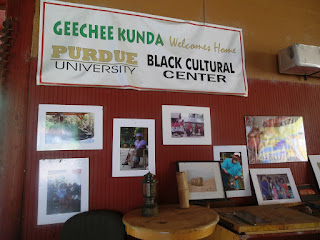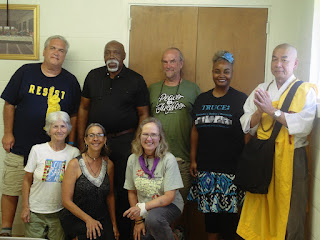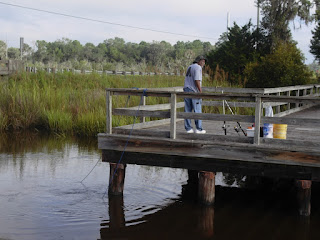Last month, I participated in a walk from Savannah to King’s Bay, Georgia. The walk was titled the Disarm Trident Peace Walk, and we were walking to bring attention to the King’s Bay Naval Base, the home of Trident II submarines, which can carry up to twelve D5 missiles. Each of these warheads is six times more powerful that the atomic bomb that was dropped on Hiroshima, Japan. These weapons are among the most dangerous weapons ever invented.
 |
| Beth, Dandelion, and Ralph. |
On September 7th, the fourth day of the walk, a few of us were looking for a good site for a lunch break. We were just outside of Midway, Georgia, and we had already rejected a few sites as not having enough shade when we found the Geechee Kunda Museum.
The Geechee Kunda Museum is located in Riceboro, Georgia. It is dedicated to the history of the Gullah Geechee people. The museum is full of artwork and information about life in the low country of the southeastern coast.
 |
| Welcome to the Geechee Kumba Museum. |
When we arrived, we were met by Dandelion, who invited us to look around. We went into a small historical museum, which had a good number of interesting artifacts. There were a few other buildings, as well, that we visited.
When the rest of the walkers arrived, a man named Greg told us about the museum and about the history of the Gullah Geechee people. He said that the Gullah Geechee people were descended from Africans, who were brought to the southeastern coast to work as slaves.
They were specifically chosen because they had an expertise in growing rice, and the European planters, who wanted to establish rice plantations, had no idea of how to grow rice.
The slaves were required to clear ground to make it suitable for rice growing. They had to do all of the work, without the benefit of farm animals.
 |
| Abuse of slaves in the United States was an everyday occurrence. Above are some of the tools of torture used by slaveowners. |
The slaveowners decided that clearing land was too dangerous for animals, but not for people, especially if those people were slaves. Approximately ten percent of the slaves who worked in the rice plantations, which were considered to be killing fields, died between 1833 and 1861.
The slaves worked on a “task” system. They had a variety of tasks that they had to accomplish in a day. Once they were done with their tasks, they could have free time. They ran businesses during their free times. In cities, such as Savannah, some of them hired themselves out as artisans.
They had more autonomy than slaves in other parts of the south, probably because the slave owners were afraid to go into the rice plantations because of the risk of malaria. People of African descent had more immunity to malaria than those of European descent. There were other dangers, too, such as cholera epidemics and a dramatically higher infant mortality rate than for the plantation owners, who, when summertime approached, moved away from the coast and the swarms of mosquitoes to inland plantations, called “retreat plantations.”
 |
| This is a Bible verse, written in English and translated into Gullah. |
The Gullah Geechee people had come from various parts of Africa and they did not speak the same language. They created two languages, one called Gullah and the other called Geechee, so that they could communicate with each other. Geechee is a Creole language that combines elements of various African languages with some Spanish and some English.
It developed in the sea islands, off of the coast of the Carolinas, Georgia, and Florida. Gullah is a combination of English and several African languages.
After the Civil War, the plantation owners fled from the coast, because of the mosquitoes and because of a series of hurricanes. The Gullah Geechee people remained and were able to maintain their traditional culture until the middle of the twentieth century, when developers started transforming old plantations into resorts. The Gullah Geechee worked hard to prevent development from spoiling the land that they had owned since emancipation.
Today, about 250,000 people along the southeastern coast speak Gullah, which is recognized as a Creole language. For years, Gullah speakers were called ignorant for speaking their native language. Attitudes later changed when Gullah started to be recognized as a distinct language.
The language, however, survived. In 2005, a Gullah version of the Bible was published, and, in 2017, Harvard University offered a course in the Gullah language.









Very interesting history lesson! There are many Gullahs on John's Island in SC and I love learning more about the their history
Like Martha, I learned about this group while in South Carolina. It's a shame that they managed to survive long enough to be hassled once again by the rich white folks.
Interesting. Blog story. Alice
I'm definitely putting this museum on my to-do list! I grew up watching that old show, Gullah Gullah Island. I had no idea back then of its cultural significance. My family and I were able to learn a little about the Gullah Geechee while on vacation in Charleston, SC a few years ago, but it left me wanting more. Thanks for this informative blog!
Times have changed for sure. In the Charleston, South Carolina area, Gullah culture is studied. I've met several Gullah sweetgrass basket artists over the years, and even went to a Civil War reenactment where they had a Gullah woman explaining about their culture. I've eaten the Carolina Gold (not the same as supermarket Carolina rice) rice that was raised by the slaves. It's a fascinating, and harrowing history.